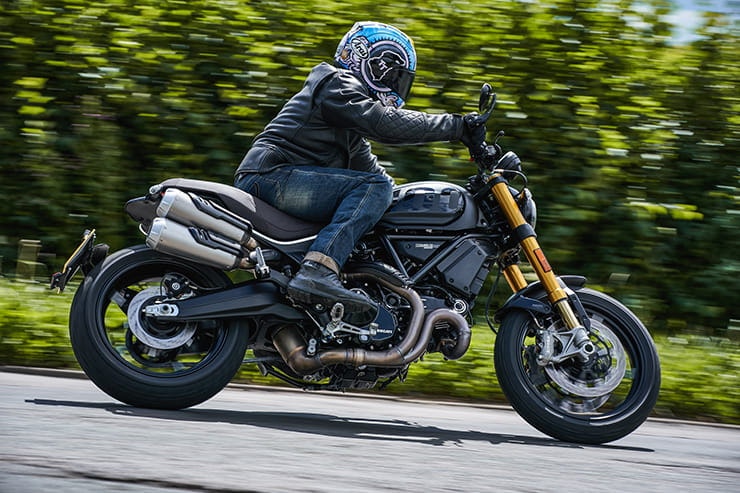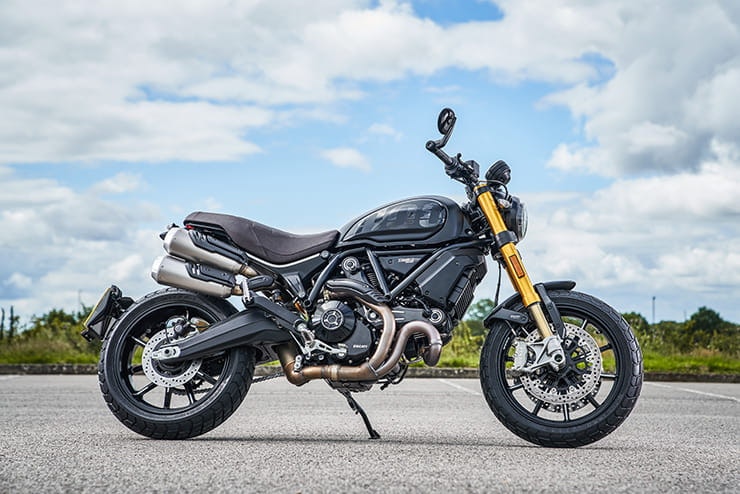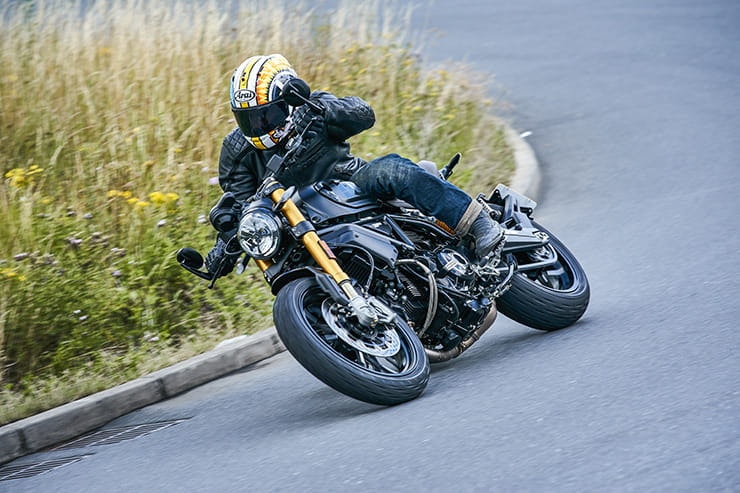Ducati Scrambler 1100 Sport PRO (2020) review
BikeSocial Road Tester
22.07.2020
Overview
New for 2020, Ducati’s ‘top-spec’ Scrambler 1100 Sport PRO, is the most advanced Ducati Scrambler yet. For this year, the Italian manufacturer has introduced two new Euro-5 compliant models, the topflight 1100 Sport PRO with fully-adjustable Öhlins suspension, and the 1100 PRO distinguishable by its Marzocchi front suspension and Kayaba rear. Both models use the same lovely air-cooled 1079, Desmodromic L-twin, which now meets Euro-5 regulations. There are also a plethora of design changes, which include a restyled rear end with unique double-stacked exhaust, and repositioning of the number plate.
We head out on a perfect summer’s day to test ride the two new models.
Ducati’s 234hp Superleggera V4 and the fierce Ducati Streetfighter V4 might be grabbing all the headlines, and without doubt they are breath-taking to ride, but for a summer evening blast, the new Scrambler 1100 Sport PRO is the bike I’ve been waiting for. Why? Because you don’t need to dress like a power ranger or ride on the wrong side of the law to get your kicks. Simply grab your leather jacket and (protective) jeans and enjoy the ride and the road.
Ducati’s big Scrambler has always hit that simple brief and is arguably the ultimate summer’s evening bike – so I couldn’t wait to get my hands on the new, even more desirable Sport PRO.
Looks, style image
Usable power
Easy, yet sporty handling
Is a little pricey
No TFT clocks
Prefer conventional mirrors not bar end
Above: Sport PRO has the black tank and gold forks while the PRO has a silver and black combo
2020 Ducati Scrambler 1100 Sport PRO Price
For 2020, there are two new models to choose from. First, you have the standard Scrambler 1100 PRO (£11,295), which comes with fully adjustable 45mm Marzocchi forks and a Kayaba side-mounted direct shock, adjustable for pre-load and rebound. It comes in an ‘Ocean Drive’ livery and with wide bars, which you’d normally associate with the traditional Scrambler.
Then, if you wish to spend a little more money, the £12,795 Scrambler 1100 Sport PRO uses the same air-cooled engine but fully adjustable, 48mm Öhlins forks and an Öhlins rear shock, again directly side-mounted and adjustable for pre-load and rebound. The bars are now lower, with café racer-style bar end mirrors and is presented in matt black.
Power and torque
Both Scramblers share the same heartbeat, the iconic, air-cooled 1079cc L-twin. Despite the engine now conforming to tight new Euro-5 regs, power and torque remain the same at 86hp at 7500rpm and 65ftlb at a low 4750rpm.
The handsome air-cooled engine can trace its route back through the Ducati family where a remarkably similar motor was used in the Monster back in 2011 when, without tight emission laws, it produced a quoted 100bhp. Against the retro competition the PRO is down on power but does deliver a wide spread of useable torque. I, for one, am happy Ducati stayed with a soulful air-cooled motor rather than seeking more power and opting for a more up-to-date water-cooled lump which would be both ugly and relatively lacking in character.
Engine, gearbox and exhaust
Some, of course, will only look at the peak power and feel a little short-changed but that figure only tells a 25% of the story. The Italian-made engine is one of the most attractive motors you can buy while the new, double stacked exhaust is a huge visual improvement over the old model and looks like a classy factory aftermarket item. Thankfully it sounds as good as it looks and has a nice little burble at tick over as well as a charismatic chorus on the throttle. It’s not as soulful as older generation air-cooled Ducatis but, taking into account the regulations Ducati has had to conform to, it’s impressive.
Revised fuelling for 2020 hasn’t meant any loss any of refinement. If you haven’t ridden a Ducati twin for a few years, that infamous snatchy fuelling is all but a distant memory. From small throttle openings it is is smooth and precise with usable torque from low down in the rev range and a willingness to pull away from slow speeds in a tall gear.
Then you just keep short-shifting though the smooth gearbox while enjoying successive dollops of grunt. If you find yourself revving the Scrambler PRO above 7500rpm and towards the soft rev limiter then, sorry, you’ve purchased the wrong bike. Ride the torque, however, and it is more than quick enough especially as it weighs just 189kg (dry).
This is usable, unintimidating performance yet still enough to have a jolly time with, and to pop the front wheel up in the lower gears if that’s your bag. When I first rode the original 803 Scrambler back in 2015 on its press launch, I loved its style, image and handling, but as an experienced rider was left a little deflated by a shortage of power. I wanted another 20-30bhp, just a little extra grunt to chase the odd bike down a country lane, and Ducati answered my wishes with the 1100 version.
2020 Ducati Scrambler 1100 Sport PRO Economy
As you’d expect from a relatively low-revving air-cooled twin, fuel economy isn’t bad, ranging from high 40s to low 50s. The sculpted 15-litre fuel tank gives a range of around 155 - 170miles, which is useful. The unique digital clocks have two trips, a digital fuel gauge along the bottom and range. There isn’t an mpg readout, though, so you have to work that out yourself when you fuel up.
Handling, suspension, chassis and weight
Starting with the sportier Öhlins-clad Sport version, the bars are much lower and straighter, giving an aggressive stance, especially when compared to the standard PRO model with its traditionally wide Scrambler bars. The Sport’s new ergonomics move you further forward in the chassis, while bar end café racer-style mirrors give the new model a sportier feel.
On the move you immediately feel the Scrambler’s plus points: ease-of-use and natural ability which is mainly down to its intuitive handling and that low weight. There’s no need for a getting-to-know-you period with the Sport PRO, instead it’s into the first series of corners with confidence. The Öhlin’s suspension is controlled but isn’t too sporty-firm; in fact, the ride is comfortable and plush, which is an achievement given there’s no rear linkage on the suspension. Certainly, no complaints from me on broken surfaces and speed humps.
Thanks to the engine character and attitude you don’t dive into corners heavy on the radial Brembo stoppers and back wheel in the air… instead it’s more of a flow, which the Scrambler loves. You roll into bends, carry corner speed, feel the feedback through that quality suspension then use the torque on the exit. The Pirelli MT60RS rubber might be styled like race wets, but the tyres handle and grip far better than they look, plus you have cornering ABS on the way in and lean-sensitive traction control on the way out. Mid-corner there is ample ground clearance; this Scrambler isn’t afraid of getting cranked over.
On the test, I deliberately attacked poorly surfaced roads at speed to find a chink in the Ducati’s armour as this is where a light bike with sporty suspension could struggle. But the Scrambler Sport PRO came back with all the answers including impressive stability at speed that boosts rider confidence. On an awkward, twisty, bumpy back road, the relatively underpowered Scrambler could, in the right hands, give a sports bike a run for its money.
Just because the PRO model isn’t dripping in Öhlin’s suspension doesn’t mean Ducati went to a car boot sale for its suspension. It’s still high quality, with Marzocchi on the front and Kayaba on the rear, with the same adjustment options as the top model. The MT60RS tyres remain the same, as do rake, trail, all other chassis dimensions and, according to Ducati, the dry weight too.
That said, traditional and more upright bars give the sensation the PRO model is a fraction lighter, which is possibly because the wide bars give you more leverage which allows you to turn the bike with ease. The Sport model is extremely agile but the standard PRO is even more toy-like.
Again, on the standard PRO model the ride quality is impressive, possibly a fraction softer with less load on the spring and more laden sag on the rear compared to the Sport. The main difference, aside from the stance, is how the suspension copes with road imperfections, bumps and crests at speed.
The Sport is more composed: it holds its weight, the suspension moving freely whilst keeping the main body stable and giving feedback – like a swan that’s so graceful on top, legs moving frantically below. On the Marzocchi/Kayaba PRO there is more jolting at speed, it’s not as smooth or as quick to react or iron the road flat like the Öhlins set-up.
At speed, when you really start to push the handling, the Öhlins set up is always controlled. On the road, you’re nowhere near the limitations of the Sport’s suspension set up, but on the standard bike, if you decided to put your head down and really go for it, the limitations wouldn’t be too far away.
Equally, new or inexperienced riders may prefer the softer set up of the standard model, and again if you’re riding hard, pushing the handling boundaries, you possibly bought the wrong bike. And if you’d never ridden the Sport you’d find little to fault with the standard PRO. It’s bit like eating a steak at a Premier Inn: fine, unless you’ve just had one at a top-class restaurant.
I’m still unsure which new Scrambler I prefer. Yes, the Öhlins set-up works better on the Sport model, but I prefer the taller, wider, more upright riding position of the standard PRO. You can push it into corners almost Supermoto like, rather than hanging off the inside, which feels unnatural on a Scrambler.
Above: It’s all in the detail – twin pipes, seat, twin cylinder motor and the double clock (Sport PRO) plus yellow band on the silver tank (PRO)
2020 Ducati Scrambler 1100 Sport PRO Brakes
Both the PRO and the Sport PRO have the same Brembo radial set up, gripping two 320mm discs (as opposed to the single item on the 803 Scrambler). And cornering ABS comes as standard on both models. The only difference affecting the braking performance is the difference in the front forks. The standard model is a little softer and dives a little quicker, but you’d only notice the difference between the two in extreme situations or on track. The braking force is impressive, and you can sometimes feel the ABS working on the rear, but otherwise isn’t intrusive.
Rider aids and extra equipment/accessories
The Ducati safety pack comes as standard on both models and is identical on both machines. As mentioned, there’s excellent cornering ABS and also lean-sensitive traction control, which can be deactivated at a standstill.
To make life simpler there are three rider modes – City, Journey and Active… yes, they moved away from the normal ‘Urban, Touring and Sport’ to keep the Scrambler marketeers happy. City mode cuts 10bhp, offers a soft throttle map and increases the traction control. Journey and Active are both full power but have different throttle characteristics, and TC settings. It’s relatively easy to change between the modes on the move and the simple dash is relatively straightforward and easy to use. There aren’t countless sub-menus within menus and you don’t have to be IT expert to work it all out.
Non-intrusive ABS is always a bonus but you could argue whether you really need changeable traction control or a rider mode that reduces the Scrambler’s 86hp any further, especially on perfect summer days (like we had on test) when the grip seems endless. I’d imagine many Scramblers will find themselves in fashionable cobbled city streets of Rome, Paris, and Barcelona and piloted by relatively inexperienced riders. It would certainly be embarrassing to high-side on wet and cold cobbles as you leave a fashionable restaurant.
As you’d expect, the new Scrambler comes a huge number of accessories for both you and your bike. You’re not just buying a motorcycle, remember, you’re buying into ‘the land of joy’, or ‘just PROs’ as is the new hashtag. Some may grimace at the marketing and ‘cool’ imagery, but it works for Ducati, hitting a new audience. And I have to say the clothing and accessories range really is pretty cool.
Rivals
In this retro cool market, there is a wide choice of bikes available, manufactures have seen a growth in the segment, and all want a slice of the cake.
2020 Ducati Scrambler 1100 Sport PRO Verdict
I was a fan of the 2018 version of Ducati’s Scrambler 1100. I rated its simplicity, yet it was sophisticated, stylish, handled, and just had enough power to make you giggle. However, Ducati has now upped the game even further and I love the new styling, the twin stack exhaust and the separate number plate holder. For styling and image, the new Scrambler is ticking all the boxes and is a significant step above over the older bike.
However, in terms of performance and handling, it is not. If you are wanting more power and improved handling, then you will be disappointed. But if you are hoping for extra style, arguable the best in this sector, then look no further. Your only decision now: PRO or Sport PRO?
2020 Ducati Scrambler 1100 Sport PRO Specification
What is MCIA Secured?
MCIA Secured gives bike buyers the chance to see just how much work a manufacturer has put into making their new investment as resistant to theft as possible.
As we all know, the more security you use, the less chance there is of your bike being stolen. In fact, based on research by Bennetts, using a disc lock makes your machine three times less likely to be stolen, while heavy duty kit can make it less likely to be stolen than a car. For reviews of the best security products, click here.
MCIA Secured gives motorcycles a rating out of five stars, based on the following being fitted to a new bike as standard:
A steering lock that meets the UNECE 62 standard
An ignition immobiliser system
A vehicle marking system
An alarm system
A vehicle tracking system with subscription
The higher the star rating, the better the security, so always ask your dealer what rating your bike has, and compare it to other machines on your shortlist.
Looking for bike insurance? Get a quote for this motorcycle with Bennetts motorbike insurance


